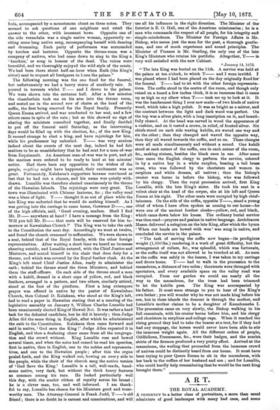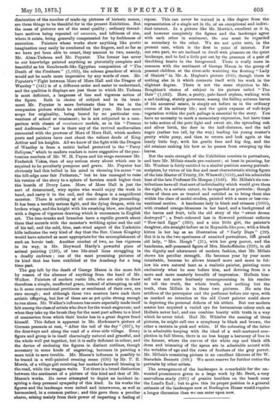ART.
THE ROYAL ACADEMY.
A TENDENCY to a better class of portraiture, a more than usual admixture of good landscapes with many bad ones, and some
diminution of the number of made-up pictures of historic scenes, are three things to be thankful for in the present Exhibition. But the mass of pictures are of the usual quality ; ordinary thread- bare motives being repeated ad nauseam, and loftiness of aim, where it exists, being generally compensated for by feebleness of execution. Painters whose works show anything like poetic imagination may easily be numbered on the fingers, and as far as we have yet been able to count, they amount to two, namely, Mr. Alma-Tadema and Mr. Poynter. The former has never to our knowledge painted anything so pictorially complete and beautiful as his Rembrandt-like Egyptian composition of "The Death of the Firstborn" (1,033), the solemn grandeur of which would not be made more impressive by any words of ours. Mr. Poynter's "Fight between More of More Hall and the Dragon of Wantley " (541) is of a different order and easier to understand, and the qualities it displays are just those in which Mr. Tadema is most deficient, a largeness of line and vigorous action of the figure. Both in choice of subject and in its treat- ment Mr. Poynter is more fortunate than he was in the companion picture which he exhibited last year. He has more scope for originality, being bound by no particular con- ventions of school or treatment ; he is not subjected to a com- parison with classic of renaissance models, as in his "Perseus and Andromeda ;" nor is there any of the revived medivevalism connected with the prowess of More of More Hall, which modern poets and painters have cast about the valiant deeds of King Arthur and his knights. All we know of the fight with the Dragon of Wantley is from a satiric ballad preserved in the "Percy Reliques," which to modern readers is more suggestive of the pan- tomime combats of Mr. W. H. Payne and his stage successor Mr. Frederick Yokes, than of any serious story about which one is required to be peculiarly pompous and grave. Mr. Poynter has obviously had this ballad in his mind in choosing his scene "on the hill-edge near fair Petheram," but he has managed to raise his version of the story to a sphere of heroism much higher than the boards of Drury Lane. More of More Hall is just the sort of determined, wiry squire who would enjoy the work in hand, and carry it to the end, and the dragon is a magnificent monster. There is nothing at 911 comic about the proceeding. It has been a terribly serious fight, and the dying dragon, with its broken wings, and the knight with his swashing blow, are depicted with a degree of vigorous drawing which is uncommon in English art. The tree-trunks and branches have a reptilic growth about them that accords with the monster's writhing spine and the coil of his tail, and the cold, blue, east-wind aspect of the Yorkshire hills indicates the very kind of day that the Rev. Canon Kingsley would have selected as most appropriate for the accomplishment of such an heroic task. Another combat of two, no less vigorous in its way, is Mr. Heywood Hardy's powerful piece of animal painting (126), of two life-sized lions struggling in a deadly embrace ; one of the most promising pictures of its kind that has been exhibited at the Academy for a long time past.
The gap left by the death of George Mason is the more felt by reason of the absence of anything from the hand of Mr. Walker. Painters of modern rustic life, who are able to draw therefrom a simple, unaffected grace, instead of attempting to add to it some conventional prettiness or sentiment of their own, are rare enough ; and although these two masters have each their artistic offspring, but few of these are as yet quite strong enough to run alone. Mr. Walker's influence has more especially made itself felt among the class of artists who draw forthe wood-engravers; and when they take up the brush they for the most part adhere to a kind of mannerism from which their leader has in a great degree freed himself. This defect is apparent in Mr. Herkomer's picture of German peasants at rest, "After the toil of the day" (657), by the doorways and along the road of a river-side village. Every figure and group is in itself charmingly natural and graceful, and the whole well put together, but it is sadly deficient in colour, and the device of enclosing the figures in distinct outlines, though necessary in some kinds of engraving, becomes in painting a mere trick to save trouble. Mr. Mason's influence is possibly to be traced in a well-painted evening scene (636) by Mr. P. R. Morris, of a village girl receiving her mother's farewell blessing in the road, while the waggon waits. Yet there is a broad distinction between the sentiment of a picture of this kind and that of Mr. Mason's works. He never attempted to depict an incident in- spiring a deep personal sympathy of this kind. In his works the figures and the landscape were united and interwoven, as well as harmonised, in a common pathos ; and this gave them a peculiar charm, arising mainly from their power of imparting a feeling of repose. This can never be oerived in a like degree from the representation of a single act in ffe, of an exceptional and indivi- dual interest. In a picture like dr. Morris's, excellent as it is, and however completely the figuies and the landscape agree with each other in sentiment, the one must be regarded as secondary to the other. We are not quite sure, in the present case, which is the first in point of interest. For our own part, we are inclined to dwell with pleasure on the quiet landscape, and to feel a little put out by the presence of a pair of throbbing hearts in the foreground. There is really more in common with the sentiment of George Mason in the group of peasant children at the river-side watching the floating "Lady of Shalott " in Mr. A. Hughes's picture (949), though there is nothing else in it which connects itself with his work in the slightest degree. There is not the same objection to Mr. Boughton's choice of subject in his picture called "The Heir" (1,062). Here, a pretty, pale-faced orphan, walking with a sad-looking, stately governess, among the falling autumn leaves of his ancestral estate, is simply set before us in the ordinary course of his solitary life ; and the quiet expanse of well-kept vegetation within the park palings is essential to the story. Yon have no necessity to mark a momentary expression, but have time to take notice of the pure light and sweet air, the spreading oak and silver birch, the deer in the half-distance, and the tall negro (rather too tall, by the way) leading his young master's pretty white pony, and then to return and look again at the lonely little boy, with his gentle face and big dog, and the old retainer making his bow as he pauses from sweeping up the leaves.
But the main strength of the Exhibition consists in portraiture, and here Mr. Millais stands pre-eminent ; at least in painting, for Mr. Woollier is fairly entitled to a similar position among portrait- sculptors, by virtue of his fine and most characteristic sitting figure of the late Master of Trinity, Dr. Whew ell (1516), and his admirable bust of the late Professor De Morgan (1549). Mr. Millais's six con- tributions have all that sort of individuality which would give them the right, to a certain extent, to be regarded as portraits ; though three of them are so treated and entitled as to bring them also within the class of model-studies, painted with a more or less con- ventional motive. A handsome lady in black and crimson (1005), with crushed orange-blossoms in her hand, and a background of the leaves and fruit, tells the old story of the "sweet dream destroyed" ; a fresh-coloured lass in flowered petticoat collects "New-laid Eggs" (260), and a nice little girl, the painter's daughter, sits straight before us in Reynolds-like pose, with a black kitten in her lap as an illustration of "Early Days" (29).. But it is in the two specimens of unmixed portraiture, tht grand old lady, "Mrs. Heugh " (21), with her grey parrot, and the handsome, self-possessed figure of Mrs. Bischoffsheim (228), in all the dignity and adornment of modern fashion, that Mr. Millais shows his peculiar strength. He becomes year by year more inimitable, because he allows himself more and more to fol- low his own natural bent as a realistic painter, painting more exclusively what he sees before him, and deriving from it a more and more masterly breadth of impression. Holbein him- self was not more fearlessly uncompromising in his resolve to tell the truth, the whole truth, and nothing but the truth, than Millais is in these two pictures. He sets the artifices of the perruquier and the perfumer before our eyes, with as marked an intention as the old Court painter could show in depicting the personal defects of his sitters. But our modern master has acquired a varied eye for harmonious colour such as. Holbein never had, and can combine beauty with truth in a way which he never tried. Had Mr. Whistler the naming of these pictures, he might call one a symphony in black and brown, the other a cantata in pink and white. If the colouring of the latter is in admirable keeping with the ideal of a well-nurtured com- plexion in full bloom, there is no less happy a harmony of line in the former, where the curves of the white cap and black silk dress and trimming of the apron are in admirable accord with the wrinkles of age and the rows of feathers of the grey parrot. Mr. Millais's remaining picture is an excellent likeness of Sir W._ Sterndale Bennett (598.) We must reserve for further notice the portraits by other artists.
The arrangement of the landscapes is remarkable for the un- wonted prominence given to a large work by Mr. Brett, a very marvellous study (681) of granite boulders on the beach near the Land's End ; bat to give this its proper position in a general estimate of the landscapes now at Burlington House would require a longer discussion than we can enter upon now.



































 Previous page
Previous page